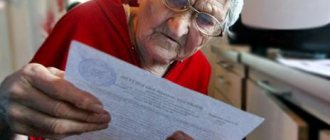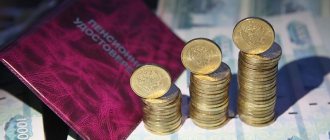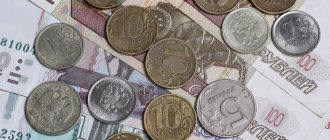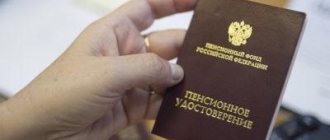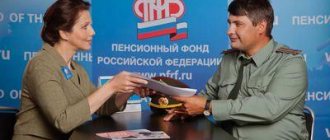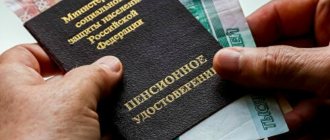The pension system in Russia has changed a lot, which is associated with the introduction of insurance mechanisms. Reform continues and something new is constantly being introduced.
Dear readers! The article talks about typical ways to resolve legal issues, but each case is individual. If you want to find out how to solve your particular problem , contact a consultant:
+7 (499) 110-56-12 (Moscow)
+7 (812) 317-50-97 (Saint Petersburg)
8 (800) 222-69-48 (Regions)
APPLICATIONS AND CALLS ARE ACCEPTED 24/7 and 7 days a week.
It's fast and FREE !
Currently, the amount of the pension depends on the salary a person receives.
Employees are covered by pension insurance, which is mandatory for everyone.
Therefore, the amount of insurance contributions paid by employers directly affects pension payments.
The concept of funded pension: what the law says
Every month the employer transfers an amount of 22% to the Pension Fund for each employee. Of this, 6% is used to form the funded part of the pension. The remaining 16% is transferred in different ways, depending on the chosen payment method. So, if the general method is chosen, then all the money is directed to the formation of the insurance part. If a mixed method is chosen, then 10% goes to the insurance part, and 6% to the savings part.
The main legislative acts regulating this issue are Law No. 424-FZ “On funded pensions”. It reveals the essence of one of the types of pension provision. In accordance with it, in certain cases, citizens are paid benefits.
Concepts
In previous legislation, pensions were referred to as labor pensions. During the pension reform, this concept was replaced by insurance.
Let's look at the main concepts that are used today in the legislation on pension payments.
An insurance pension is a monthly compensation that replaces citizens with income lost due to old age, loss of a breadwinner or disability.
For state support - monthly compensation from the federal budget to strictly defined categories of citizens who have reached seniority or old age, have become disabled, or have lost their breadwinner.
A funded pension is an indefinite monthly compensation of pension savings received through the receipt of insurance contributions from employers and income from their investment.
Insurance period is the total duration of periods determined by law for which insurance contributions were transferred to the Pension Fund.
Individual pension coefficient is a pension point on which the size of the pension depends. Determined taking into account the listed insurance premiums, the duration of the insurance period, temporary refusal to pay.
A fixed payment is part of an insurance pension in a specific amount.
Who can get it
Most citizens who allocate 6% of pension contributions to form a funded pension in a non-state pension fund hope to receive a lump sum payment upon retirement. However, not all of them can count on this. The law provides for the following conditions under which payment is made:
- Receiving funds in connection with the onset of disability.
- Receiving financial support due to the loss of a family breadwinner.
- Receiving a state pension along with the opportunity to retire in old age.
- Making pension contributions from 2002 to 2004 (payments were canceled from 2005).
- Participation in the state co-financing program and making initial contributions (it is currently no longer possible to participate in this program).
- Availability of savings.
Along with deciding the question of when to receive the funded part of the pension, it must be taken into account that the pensioner has the right to address this issue no more than once every 5 years.
In addition, the year of birth matters. Here is the age at which the funded part of the pension is received:
- Men born before 1953 and women born before 1957.
- Men and women born in 1966 and earlier.
How is it calculated
An indefinite savings payment is assigned for life in an amount calculated based on the expected duration of survival of pensioners after retirement. In 2020, this expected survival period is 252 months or 21 years. To calculate the amount paid to a citizen monthly, the amount of savings recorded in a special pension account is divided by 252 months.
Calculation example: in 2020, a pensioner issued an indefinite payment. The amount recorded in a special account with the Pension Fund was 550 thousand rubles. Taking into account the expected survival age, the monthly additional payment will be 2.18 thousand rubles. monthly. The size of a citizen’s insurance pension is 18 thousand rubles, therefore the expected funded payment will be more than 5% of the insurance benefit, which makes it possible to legally issue a funded payment.
The urgent payment is calculated according to the same principle, the only difference is that instead of 252, the accumulated amount of savings is divided by the number of months in the period chosen by the pensioner himself. A one-time payment is paid in the amount in which the amount of savings is formed; no additional calculations are made.
Conditions for receiving a one-time payment
If a citizen expects to receive a one-time payment, the following conditions must be met:
- Reaching retirement age (in connection with the pension reform, this indicator is gradually increasing for men from 60 to 65 years old, and for women from 55 to 60 years old).
- Receiving a basic old-age pension.
- Work experience (in connection with the ongoing reform, the number of years of experience is gradually increasing from 5 to 15 years).
- Statements from the recipient.
Only if these conditions are met can you expect to receive a lump sum payment.
Before reaching retirement age, transfer of money is possible if a citizen has become disabled of group I, II or III. Funds are also paid upon the death of the family breadwinner.
Required documents
Documents are submitted in two stages. The first time you only need to present a document that certifies your right to receive a pension. The second time you need to prepare the following papers:
- A copy of your ID (with presentation of the original).
- SNILS.
- Certificate of a disabled beneficiary, or other document confirming the corresponding right to payment.
If this issue is dealt with not by the pension recipient, but by a trusted person, then a power of attorney should be issued for him to carry out specific actions, and the document should be certified by a notary. In some cases, other documents may be required. They should be presented upon request by employees of the organization where the applicant is applying.
What documents need to be collected in order to receive the required pension payment?
In order to process the part of pension payments that interests us, it is necessary to provide specific information and relevant documents to the required authority. We will see what documents we are talking about in the table below.
What documents need to be submitted to the accumulative pension accrual organization?
Table 3. What documents need to be submitted to the accumulative pension accrual organization
| Document | Description |
| Statement | First of all, an application is submitted, which contains in its text a request for the formation of a funded pension or its payment. |
| Confirmation of belonging to the Russian Federation | It is also imperative to prove that you are directly related to the country that will pay you a pension. To do this, submit for consideration: · a passport of a citizen of the Russian Federation; · residence permit in Russia. |
| SNILS | The insurance number of an individual personal account must also be submitted for verification to the relevant organization; for this you need to bring there a card-certificate of its issue. |
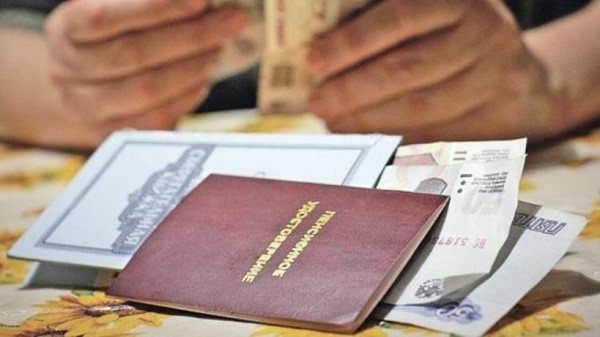
Documents can be submitted in person or through a legal representative
Documents can be submitted either personally or through a legal representative of a citizen entitled to receive funds, but only on the condition that the second mentioned person submits a power of attorney to the territorial authority, which will clearly indicate his data.
It is also possible to submit documents:
- during a personal visit;
- by sending by mail (in this case, the filing date will then be considered the day that will be stamped on the envelope with the documents at the post office);
- through the multifunctional center.
It turns out that you don’t even need to come to the organization yourself; all tasks can be completed remotely.
Receiving a funded pension for a deceased relative
If a person who had pension savings dies, then his relatives can receive these funds. If desired, the pensioner personally appoints those to whom the money will be transferred. To do this, he needs to come to the Pension Fund and write a corresponding statement. He also has the right to indicate this right in his will. If neither one nor the other was done, then the funds are transferred by inheritance according to the law.
True, you need to understand that you will only be able to receive that part of the savings that has not yet been paid. True, there is an exception to this rule. If a citizen continues to work in retirement and at the same time transferred interest to the funded part, then, despite receiving part of the money from this pension, the amount may increase due to the investment of new invested funds. In this case, the heirs can count on that part of the pension that has not yet been indexed at the time of the pensioner’s death.
The rights of heirs to a funded pension have some restrictions, which are as follows:
- If the money was transferred from maternity capital, then upon the death of the mother, the spouse can receive it. If it is not there, then only born children.
- If the funds were transferred from her own savings, then the widow will be able to use the method of receiving the funded part of the deceased husband’s pension in accordance with her turn.
- If there is a will or an application to the Pension Fund of the Russian Federation, which sets out the will of the deceased, distribution is carried out in accordance with this procedure.
- If the deceased did not notify anyone where he kept the money and did not leave a will, then the heirs need to go to the nearest branch of the Pension Fund of Russia. Experts will tell you where they should go next.
Documents you need to have with you:
- Passport.
- A document confirming the death of a relative.
- Documentary proof of relationship with the deceased.
- An application to receive pension savings belonging to the deceased.
Pension Fund specialists must make a decision within 5 days after receiving the application. If it is decided to refuse an applicant, this must be motivated. If the outcome is positive, the funds are transferred in a way convenient for the applicant.
Rules for providing funds
Citizens can apply for the establishment and issuance of a funded pension at any time, immediately after reaching retirement age (persons who finish work early also have this right). The application form for a one-time payment can be downloaded here.
In order for funds to be provided, a person must fill out an application and submit it directly to where the savings are stored.
This is interesting: Information about tax debts of a legal entity
In simple terms, if the money was transferred to the management company, then the payments will be handled by the Pension Fund of the Russian Federation.
If the funds were transferred to the Non-State Pension Fund (NPF), then he will be responsible for assigning accruals.
The insured person can choose one of three types of financial payments. Namely:
The latter type can only be chosen by people of certain categories (disabled people, people receiving survivor subsidies, etc.).
How is the calculation made?
In order to calculate the amount of pension contributions, the formula is used:
| NP | Direct amount that is paid to a person in person |
| Mon | Total pension savings that a citizen has in his account by the time the period when their payment can begin |
| T | Average coefficient of the expected period of accrual of pension savings, calculated in months |
In the event that it is necessary to calculate a fixed-term funded pension:
| JV | Urgent payment of funded pension |
| Mon | The amount of total savings stored in a person’s account |
| T | The period for accrual of funds/ which is indicated in the application (according to the law, the period must be at least 10 years) |
With a one-time payment, citizens receive the entire amount of money “in their hands” at once. This opportunity is provided only to the following categories of people:
- citizens whose total savings are less than 5% of the insurance pension;
- persons who have been assigned benefits for the loss of a breadwinner, disability, or state pension benefits for elderly citizens with a small number of points or insufficient work experience;
- pensioners who are the spouse or direct relatives of a person with savings savings who died before retirement.
A one-time benefit cannot be assigned to people who have previously received it. As for pensioners, they have this right, however, not earlier than after 5 years.
What documents need to be submitted
In order for a person to be assigned a funded pension in a non-state pension fund or PF of the Russian Federation, it is necessary to provide a certain list of documents:
- application for the accrual of funds;
- passport of a citizen of the Russian Federation;
- pension certificate;
- SNILS;
- pensioner's ID.
Additional types of documentation may be required for the calculation of savings payments.
Peculiarities of filing an application with a non-state Pension Fund
Non-state pension funds are created for the sole purpose of making a profit. Non-state Funds take citizens' savings (accumulative capital) and invest in various projects in order to increase the amount of money.
Despite the fact that these are private commercial structures, they are strictly controlled by:
Some of the most reliable non-governmental organizations include:
The principle of using the savings funds of the Pension Fund of the Russian Federation and Non-State Pension Funds is identical. Both organizations invest money in various projects.
In difficult economic situations, when a budget deficit occurs, the Pension Fund of the Russian Federation uses these funds to calculate pensions for elderly people.
In addition, a non-state fund does not have the right to use more than 15% of its income for its needs, and in the Pension Fund of the Russian Federation there is no such restriction. If necessary, a citizen has the right to transfer his own savings from one NPF to another.
The procedure for receiving the savings of a deceased relative
Relatives of the deceased have the right to receive his savings. However, in this case, they may have a question: when can they receive a pension?
According to the law, savings can be passed on to heirs only if:
- the person died before the start of urgent or permanent payments;
- after the establishment of a fixed-term pension;
- after establishing the issuance of a lump sum (possibly if it was not previously transferred to the deceased).
If a citizen died after the appointment of an indefinite pension, then its balance is not subject to return to the second spouse and relatives.
The following heirs have the priority right to receive a funded pension of a person who has passed away:
If the deceased does not have them, then brothers, sisters, second cousins or strangers can become heirs, however, if they are included in the will.
Cumulative savings in the Russian Pension Fund or Non-State Pension Fund is an excellent addition that allows a person to improve their standard of living in old age.
In addition, such a pension can be a good financial support not only for the pensioner himself, but also for his relatives in the event of the death of the recipient.
Video: what is a funded pension payment
- Due to frequent changes in legislation, information sometimes becomes outdated faster than we can update it on the website.
- All cases are very individual and depend on many factors. Basic information does not guarantee a solution to your specific problems.
That's why FREE expert consultants work for you around the clock!
- via the form (below), or via online chat
- Call the hotline:
- Moscow and the Region
- St. Petersburg and region
- Regions
APPLICATIONS AND CALLS ARE ACCEPTED 24/7 and 7 days a week.
Receiving a funded pension indefinitely
The transfer of money is carried out depending on the amount that has been accumulated over the entire period. In this case, the payment is transferred for life every month. That's why it's called perpetual. The amount of the funded pension is calculated based on the expected payment period. Currently it is 246 months. The calculation is made by dividing the total amount in the account by 246.
It is possible to divide this amount into fewer months. Then you should wait a little while deciding when you can receive the funded part of your pension. The number will decrease with the number of months that have passed since the right to leave has arisen. However, it must be at least 168 months.
Who falls under 168 Federal Law
This regulatory act regulates the procedure for pension insurance, which is mandatory for everyone entering into an employment relationship under a contract. Workers will receive a pension that is determined by wages, or more precisely, by insurance contributions, which the employer transfers in a specially established manner.
Federal Law 168 regulates this procedure: the amount of payments, their frequency, the circle of paying persons and organizations, patterns of use and documentation. Those eligible to receive the funded part of the pension include:
- people born in 1967 and younger who chose this scheme before 01/01/2019;
- female persons born 1957-1966;
- males born after December 31, 1952, but before January 1, 1967;
- participating in the pension co-financing program;
- who have decided to use maternity capital as a means of pension savings.
This is interesting: Unified payment systems and services
Advantages and disadvantages of funded pension
The decision to transfer part of pension contributions to a management company or non-state pension fund has both positive and negative sides. The benefits are as follows:
- Possibility of choice. The future pensioner decides for himself what will happen to the funded part of the pension, where he will invest the corresponding interest. Moreover, a citizen has the right to change his choice whenever he wishes.
- Opportunity to earn high interest rates. If the NPF makes profitable investments, the citizen will ultimately receive an amount higher than that allocated by the state.
- The funded pension can be inherited by close relatives. This right does not apply to insurance payments.
- There is a risk of losing only profit. The money that was invested will be returned in any case.
- Thanks to interest, you can increase the size of your future pension.
All these advantages also have a downside in the form of disadvantages. These include the following:
- High risks. If all the money remains in the Pension Fund, the amount will certainly increase, although not by much. But in the case of a transfer to a non-state pension fund, it is unknown what will happen to the funded part of the pension. There is a risk of being left completely without profit. And due to inflation, this money may completely depreciate, since indexation is not carried out in relation to it.
- Risks can be insured. Then there will definitely be a profit, but the citizen will have to incur additional expenses.
- Withdrawal of commissions. Not everyone carefully reads the contract when concluding it. Meanwhile, it may provide for some provisions that could easily deprive the investor of interest. For example, there may be fees for cash withdrawals or penalties for early termination of the contract.
